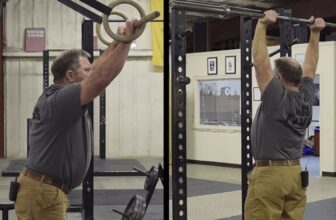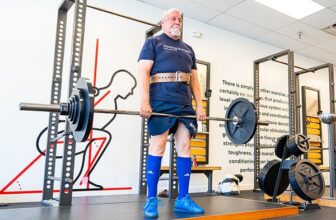
[adinserter block=”2″]
“Because that’s the way we
do it” is never an acceptable answer to a question. Neither is
“It’s always worked for me,” or “That’s the way I was taught,
and I’ve always done it this way.” If someone asks a question about
what you’re doing, an answer like this demonstrates that you haven’t
thought about why you’re doing it. Why
is occasionally important, especially if an analysis is to be
accomplished that allows the process to be applied across varying
situations. That which cannot be analyzed cannot be validated, and if
I’m just supposed to believe
you, you’re a priest, not a professional service provider. When I ask
the plumber why he lays the sewer pipe the way he does, he can tell
me that shit always runs downhill, and that’s a First Principle.
Barbell
strength training is no different. If you know what you’re trying to
do, it is possible to determine the best way to do it after a correct
analysis. And the best way might not
be The Way It’s Always Been Done, if your correct analysis tells you
otherwise. When this happens, people will be dismissive of your
efforts, since nobody likes to 1.) have their mind changed, 2.) have
to learn something new, especially when they thought they already
knew it, or 3.) look like a fool.
We
were not prepared for this when I wrote the first edition of the
book, but pushback was minimal since the first edition was not
particularly deviant from the accepted conventional wisdom. As I
continued to write, I corrected errors carried over from my having
accepted the conventional wisdom. I developed the ability to think
and analyze while I wrote, I came to some different conclusions. Over
the past 20 years we have developed some rather solid explanations
about things that had previously not been explained, or even asked
about – explanations that lead to better methods of executing and
teaching the barbell exercises. Why
turned out to be very important.
Things
like: what is the most efficient position from which to pull the bar
off of the floor; what is the best way to squat the heaviest weight;
what is the best grip to use in the bench press to involve the most
muscle mass; what is the best way to press the heaviest weight
overhead; how does heavy pulling mechanics apply to the Olympic
lifts. These
questions are not answered by claiming that everybody lifts heavy
weights their own way, because that is certainly as hell not true.
The answers were determined by careful observation of lots of heavy
lifts, and recognizing the common patterns of execution – this is
the what-part
of the explanation.
The
why-part
was then derived from basic physical science, with a lot of help from
several engineer buddies who were interested in a more analytical
approach to lifting weights. Lifting weights is an understandable
mechanical process – not
an art – to which
the laws of physics apply, and this becomes obvious with just a
little examination (I don’t remember any Doctors – MD or otherwise
– contributing to this process).
First,
and most importantly, strength
is the ability to produce force against an external resistance. Force
is measured in pounds. The more pounds you can lift, the stronger you
are. Your body, being alive, can adapt to its environment, since this
is necessary for all life to continue and has been a feature of
living things since the proverbial Day One. It’s perhaps the primary
function of your DNA. So if you slowly change your environment by
lifting progressively and incrementally heavier weights, you adapt to
that changing environment by getting stronger.
This is First Principle Number One.
Mechanics
Observations
of heavy lifts demonstrate the existence of very predictable patterns
in the movement of the body under heavy barbells. YouTube was
instrumental in this process, in that enormous numbers of lifts can
be viewed in real speed and
frame-by-frame, and without which the patterns characteristic of the
mechanics involved could not have been observed, and therefore
explained. These tools were not available before the 1990s, so
coaches operating 40 years ago may be excused for being wrong about
some things. When Taranenko cleaned 266 in 1988, in a little over 1
second, it would have been very hard to appreciate the details of
what was happening. The why-part
of those details would have been even harder to determine if you
didn’t know they were there. That excuse no longer exists.
In
the weight room, gravity operates in one direction, which is easily
understood. When we lift weights, we work against gravity.
Machine-based exercises are specifically designed to work around this
constraint in order to isolate muscle groups from their normal
musculoskeletal/mechanical environment. They remove the balance
component from the exercise, and thus abandon that aspect of the
adaptation. Squats, deadlifts, presses, and the Olympic lifts train
balance as well as strength, since it is possible to fall down while
you’re doing them. When you don’t fall down, balance has been
maintained and thus trained, and balance is important for all daily
human applications of force-production capacity.
Any
work performed against gravity must be done in the opposite
direction. Any other motion is something other than work done against
gravity, and therefore represents a lack of efficiency even though it
is sometimes necessary depending on the musculoskeletal requirements
of the lift. The lighter the weight on the bar, the more inefficiency
the system can tolerate, and vice versa: the heavier the weight, the
more efficient the mechanics must be. Even at World Record weights,
it helps to be stronger than you have to be to lift the weight, since
some inefficiency will always be present. If an observed inefficiency
in a completed lift gets interpreted as correct technique due to the
failure to understand the First Principles, this misunderstanding can
become codified in coaching dogma. This has happened many times.
And
the way to get stronger is to progressively add weight to the basic
barbell exercises. This very basic First Principle is always in
operation whether you understand it or not.
For
movement patterns executed while standing on the floor, the middle of
the foot is the center of balance, and the combined center of mass
(CCOM) of the lifter’s body and the barbell are the two points to
consider. The heavier the bar relative to the bodyweight of the
lifter, the closer the CCOM is to the barbell. For this
lifter/barbell system to be in balance, the CCOM must be directly
vertical to the Center of Balance, i.e. the mid-foot. Any deviation
from this alignment represents inefficiency that will require the
production of more force than would be necessary during the movement
of the barbell.
In
barbell training, leverage
is the tool we use to move the load. Muscles provide the force, and
your body segments – arms, legs, hips, and torso – apply the
force to the barbell. A Moment
Arm (also known as
a “lever arm”) is the distance between the barbell (upon which
gravity is acting vertically) and the point of rotation from which
the force to move it is being applied (the joint or joints – knees
and hips, etc.). It behaves like a hand turning a wrench: the longer
the distance the hand is from the bolt being turned by the wrench,
the more leverage the hand can apply. But the load on the bar applies
force back along the lever – like the bolt is turning the wrench –
and you have to be strong enough to operate the wrench. These
concepts are discussed at length in the Blue Book.
Anatomy
The
details of the way the musculoskeletal anatomy applies mechanical
force to the barbell are also discussed at length in the Blue Book.
If the purpose of strength training is to 1.) involve the greatest
amount of muscle mass 2.) over the longest effective range of motion
3.) for the purpose of lifting the most weight 4.) for the greatest
increase in strength, musculoskeletal anatomy must be considered
alongside mechanics.
Musculoskeletal
anatomy explains the fact that the shoulders are just in front of the
bar with nearly vertical shins and high hips when a heavy deadlift
comes off the floor. This is a phenomenon that is not immediately
obvious since it seems like the arms should hang vertically, and they
can’t. And that the same position is the most
efficient from
which to accelerate the bar upward in a clean or snatch, even though
they are light enough to be done from a different position
inefficiently. More acceleration efficiency means a higher bar path
with the same weight, and thus the ability to pull a heavier
weight high enough to rack.
Musculoskeletal
anatomy determines grip width in the bench press, while mechanics
primarily determines grip width in the press. Musculoskeletal anatomy
determines back angle, stance width, and the movement pattern in the
squat, while its derivative movement, the front squat, is dictated by
the mechanical rules of catching a full-squat clean. Squatting
improves the front squat, while the opposite is not true. The front
squat is not a strength training movement, but rather a part of the
sport of Olympic lifting (refer to the purpose of strength training
above), and Olympic lifters must train the front squat even though no
other sport benefits from it.
Chins,
and barbell rows for more advanced trainees, are examples of the
normal human movement pattern of pulling something towards you. Like
deadlifting the bar off the floor, the movement uses the lats,
although in a different function. Grip style and width varies the arm
muscle mass involved in the movement. Since we’re trying to involve
the most muscle mass possible, we use a supine grip for chins so the
biceps get trained.
The
upshot of this discussion is that barbell strength training is
provably the best way to get stronger by directly affecting the force
production capacity of the body using its normal movement patterns
under an incrementally progressive loading program. If these movement
patterns are strengthened, all of their derivative sub-patterns are
also strengthened. And it is possible to determine the best way to
execute each pattern for the purposes of lifting heavier weights,
thus qualitatively analyzing the activity and enabling quantitative,
predictable, and programmed improvement over time. We say “Five
Pounds a Workout” as shorthand for the process, and once all the
complicated stuff is over with, it really is that simple.
Discuss in Forums
[adinserter block=”2″]
Credit : Source Post






